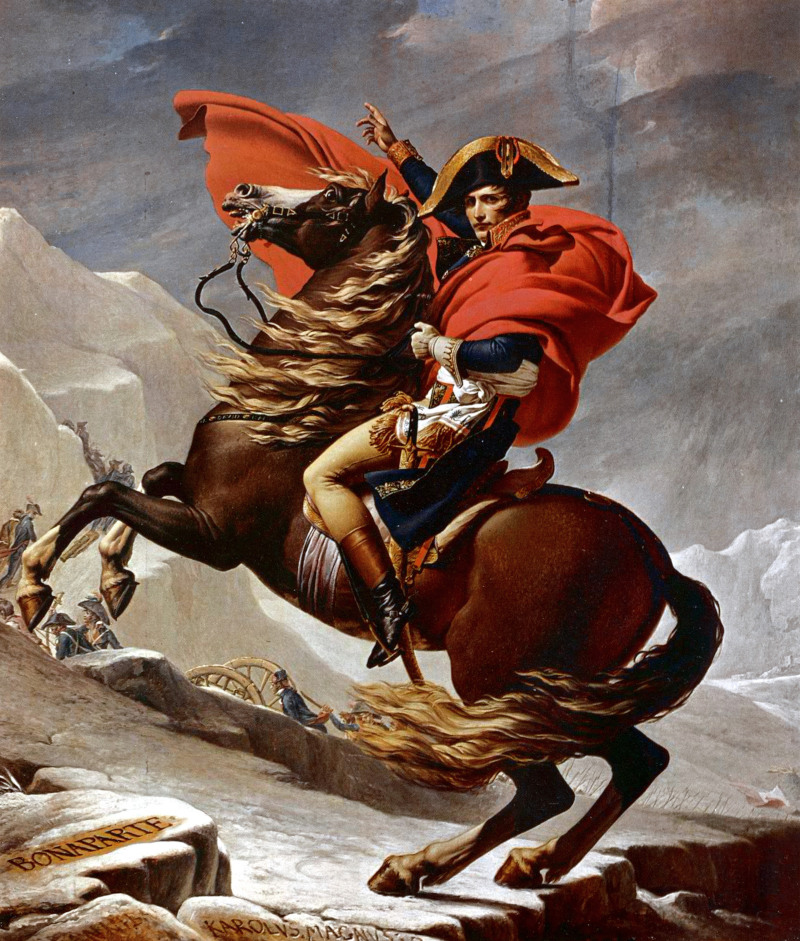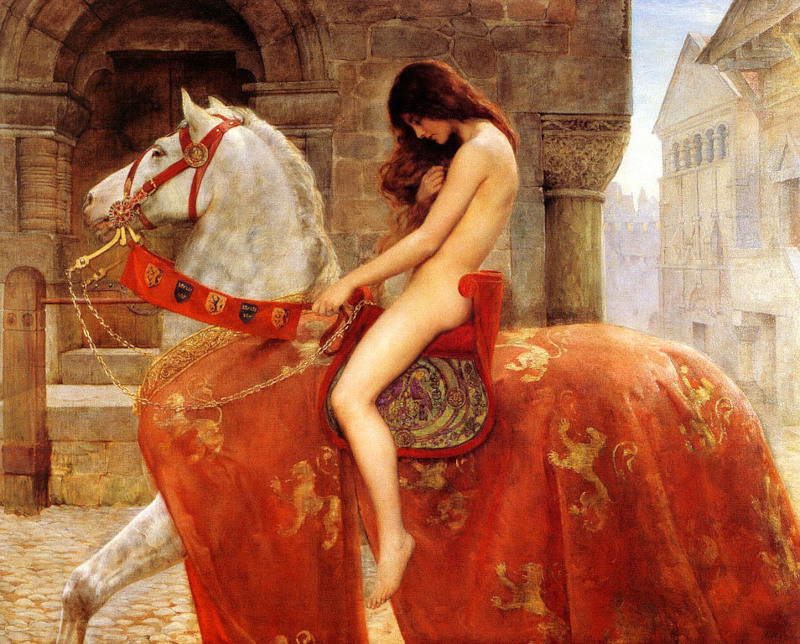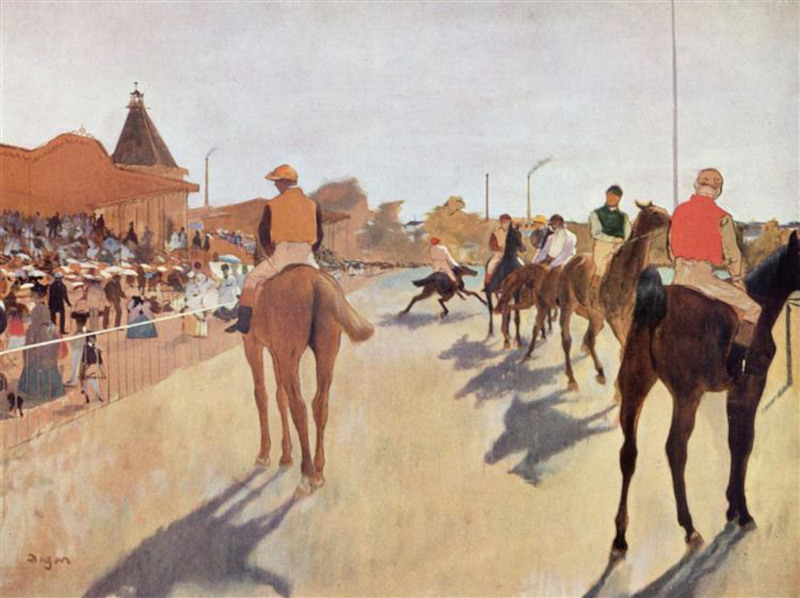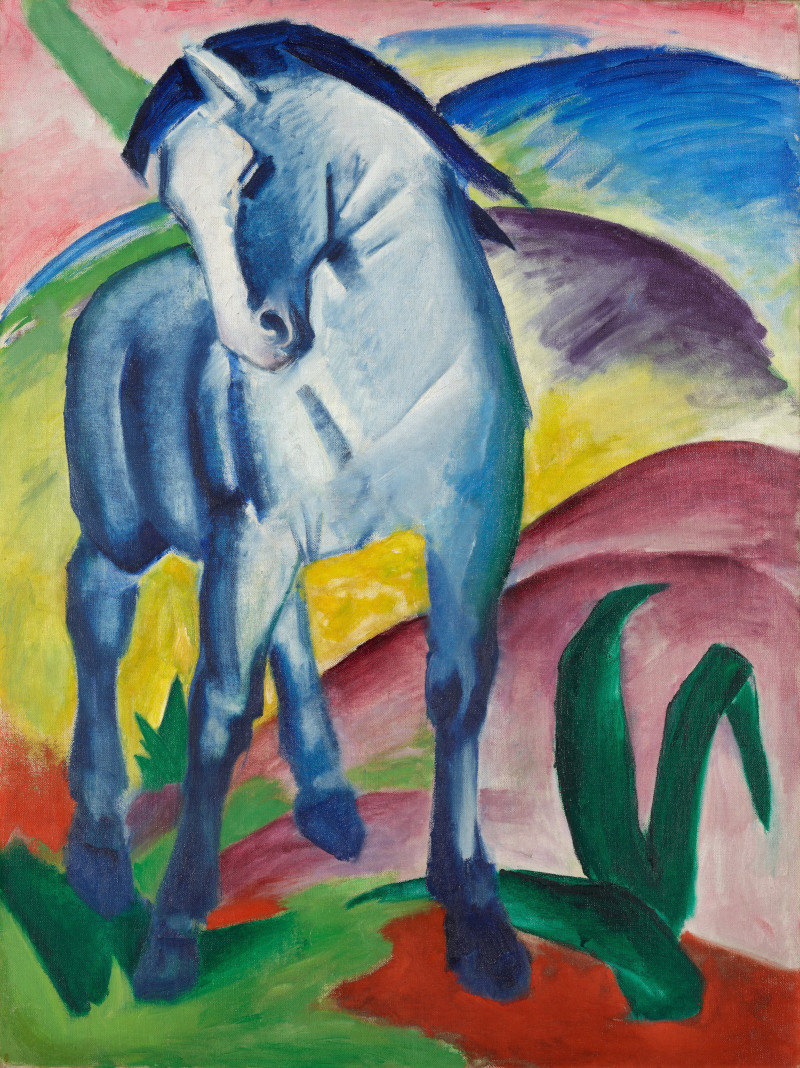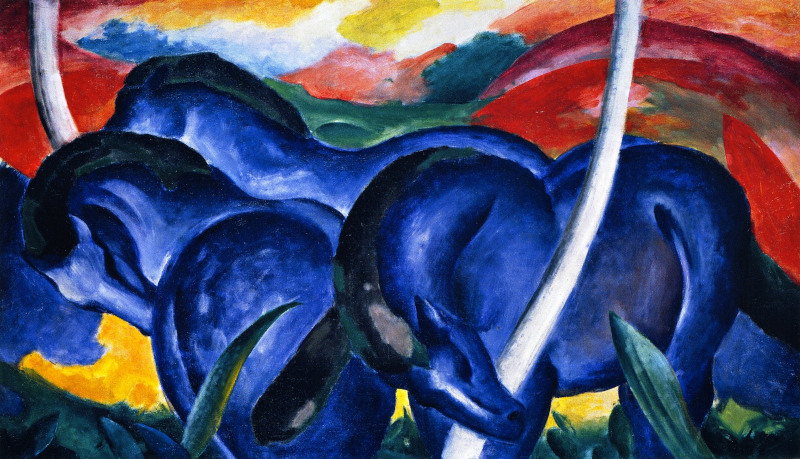Enjoy our list of horse paintings, covering the full breadth of art history.
Alongside our exhaustive list of famous paintings and drawings, we also delve into the history of horse art, including discussing its evolution over past centuries, and where it may well lead in the future. We will also comment on the changing roles of horses within society over the same period, and how that was reflected in art.
Our list below covers major artists, and many of the paintings you might have seen before. There will inevitably be some paintings not featured that you might have selected yourself, but this remains a personal list of favorites, purely for your enjoyment.
Famous Horse Paintings That Define the Genre
We have hand picked a selection of famous horse paintings below, whilst also including a few drawings within that too. The list contains a variety of artistic styles, and shows the full history of horse painting within art, since around the early Renaissance era.
The list is roughly in chronogical order, running from the likes of Leonardo and Rubens, all the way up to the 20th century with painters such as Franz Marc, Picasso and Kandinsky. It is an exciting list of paintings devoted to this majestic, beautiful creature.
The Battle of Anghiari by Leonardo da Vinci (drawing by Rubens, as copy of Leonardo's lost painting)
Whilst technically a drawing, we have included this Leonardo artwork within our selection of horse paintings because of the incredible accuracy and quality of this piece. Leonardo studied the human anatomy throughout his lifetime but eventually turned his attention to horses as well, plus a number of other animals.
The Battle of Anghiari came from a collaboration between Rubens and Leonardo, but the original painting was lost or damaged. This drawing is the closest example we can get as to how the completed painting might have looked. Note the incredible detail incorporated into this study sketch, with contorted figures which was a highly ambitious composition.
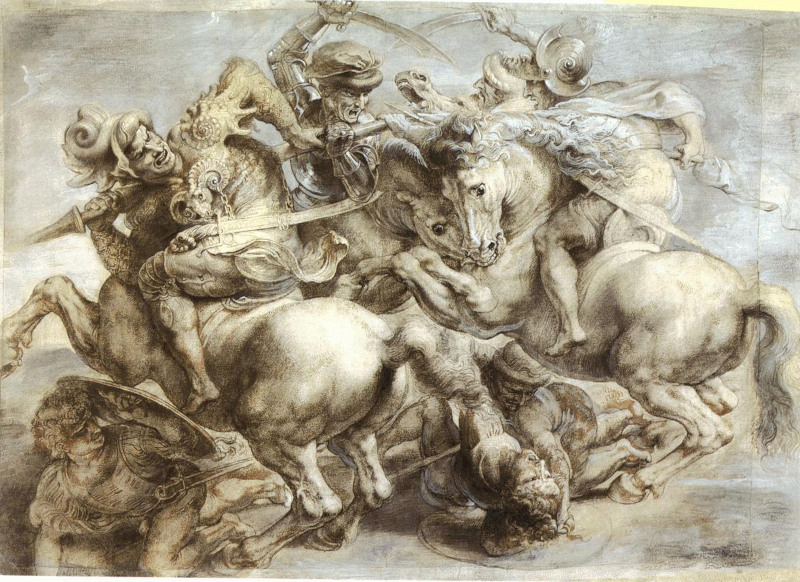 The Battle of Anghiari by Leonardo da Vinci
The Battle of Anghiari by Leonardo da Vinci
Studies of a Horse (Drawing) by Leonardo da Vinci
This drawing indicates how Leonardo would spend much of his time observing anatomies in precise detail, attempting to understand the muscle and bone structures so that his depictions could be as accurate as possible. Leonardo's work would raise the bar in horse and animal paintings, requiring others to achieve the same level of accuracy within their work.
In order to save on paper, which would have been expensive at the time, and also sometimes scarce, the artist would fill every corner of each page with studies. In this case he examines a horse from different angles, potentially considering how to depict it in a painting or sculpture (he did complete sculptures, but only relatively rarely).
 by Leonardo da Vinci.jpg) Studies of a Horse (Drawing) by Leonardo da Vinci
Studies of a Horse (Drawing) by Leonardo da Vinci
Saint Martin and the Beggar by El Greco
Saint Martin and the Beggar by El Greco captures a horse in majestic detail. Whilst its rider hands over a cloak to a local man, the horse appears calm and responsive. El Greco loved to elongate his human figures and in this painting you might notice how the figure stood besides the horse and rider is particularly tall and slim.
This painting features a cityscape in the distance and considerable detail is added to the rider's clothing, Saint Martin. The light grey tone of the horse immediately catches one's eye, and the use of a horse is often found in art as a means to raise the status of the rider, both literally but also symbolically.
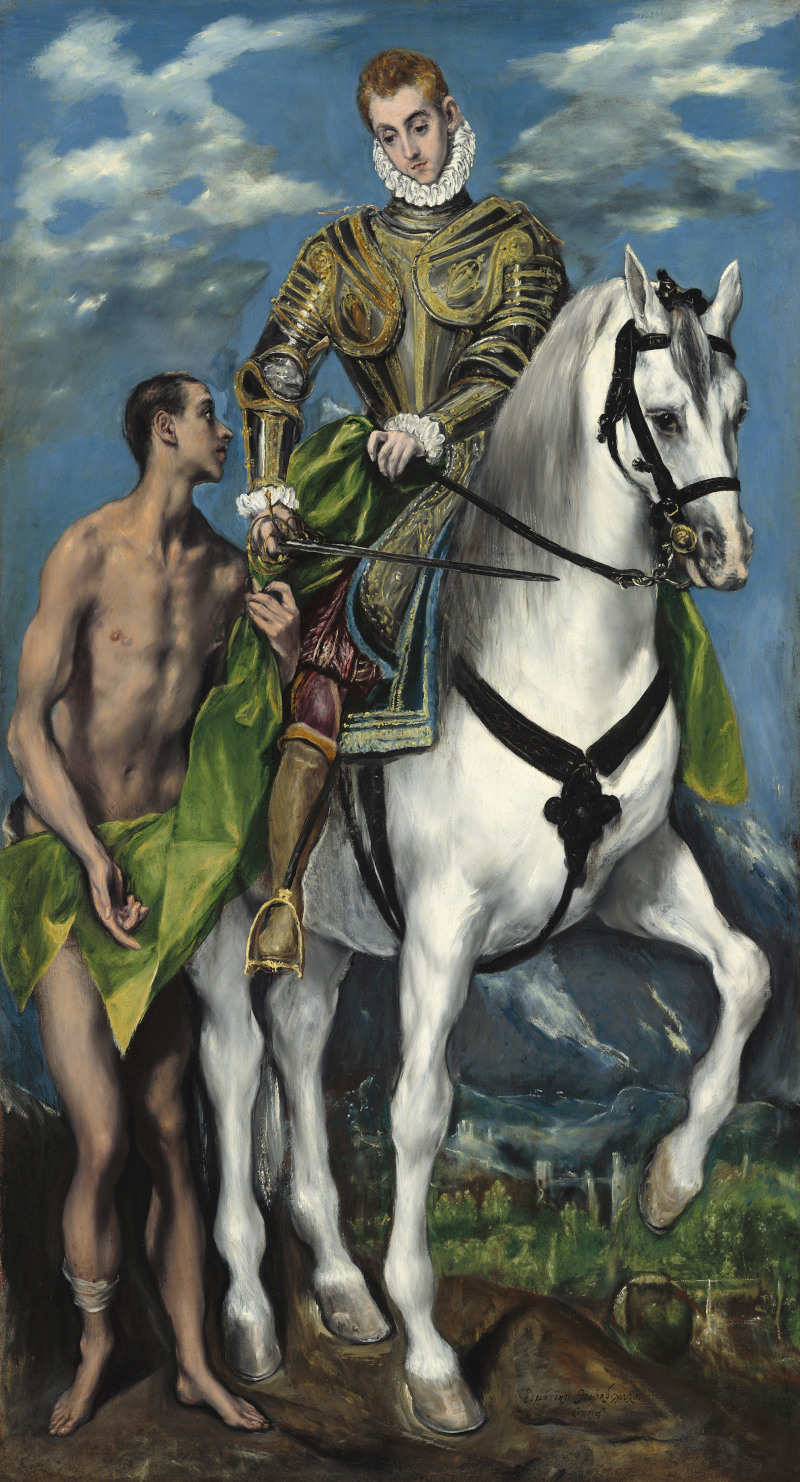 Saint Martin and the Beggar by El Greco
Saint Martin and the Beggar by El Greco
Saint George and the Dragon by Peter Paul Rubens
The Baroque era was famed for its emotion and drama, with Rubens' Saint George and the Dragon providing a great example of that. Again, we find a figure of significant status on horseback, looking down onto his subordinates. The horse is involved in battle itself, as it rises up into the air, seemingly agitated by events.
Rubens loved to feature battle scenes, where emotions and activity were at their most extreme, and typically horses could be used to signify rank and status within a scene. He would have studied these majestic creatures in great detail in order to achieve such as accurate representation in his work, where muscles would be stretched to the limit, and the animals' bodies twisted and contorted in battle.
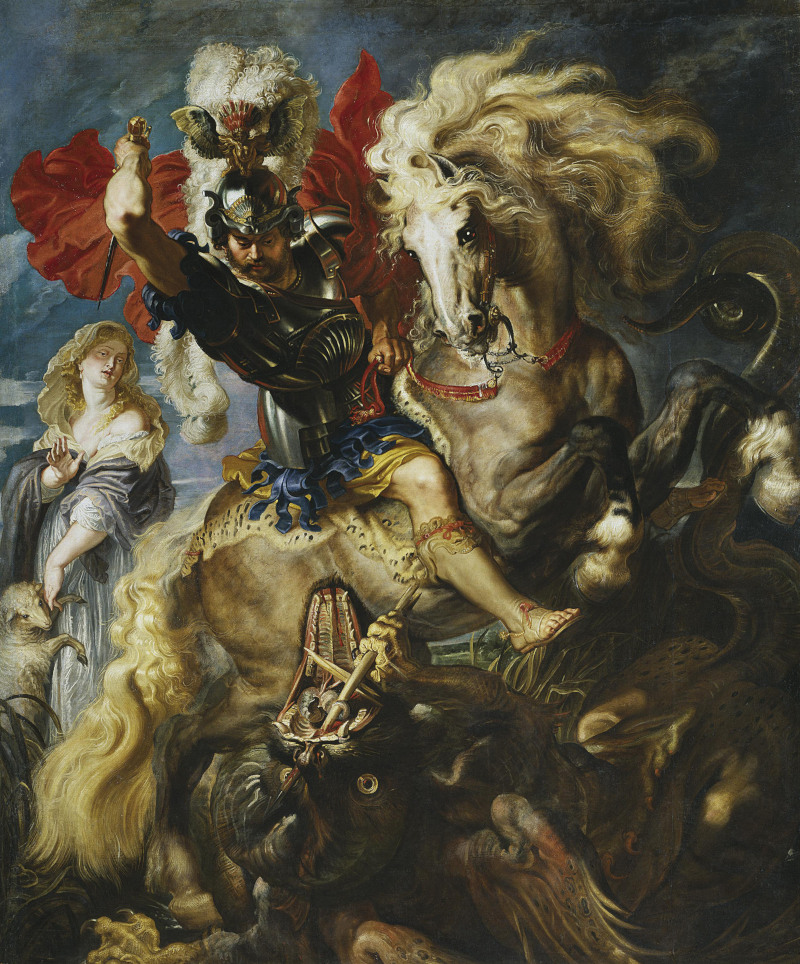 Saint George and the Dragon by Peter Paul Rubens
Saint George and the Dragon by Peter Paul Rubens
Whistlejacket by George Stubbs
Perhaps the most famous horse painting of them all, Whistlejacket by George Stubbs is a relatively simple composition which was delivered to an exceptional technical level. No artist in history would go to the lengths of Stubbs in order to replicate the anatomy of a horse, slicing the creature open many times in order to inspect its inner workings.
The advancements made by Stubbs could be taken up by others who studied his work, potentially saving them time, but also raising the bar of quality, just as Leonardo had done with his study drawings several centuries earlier.
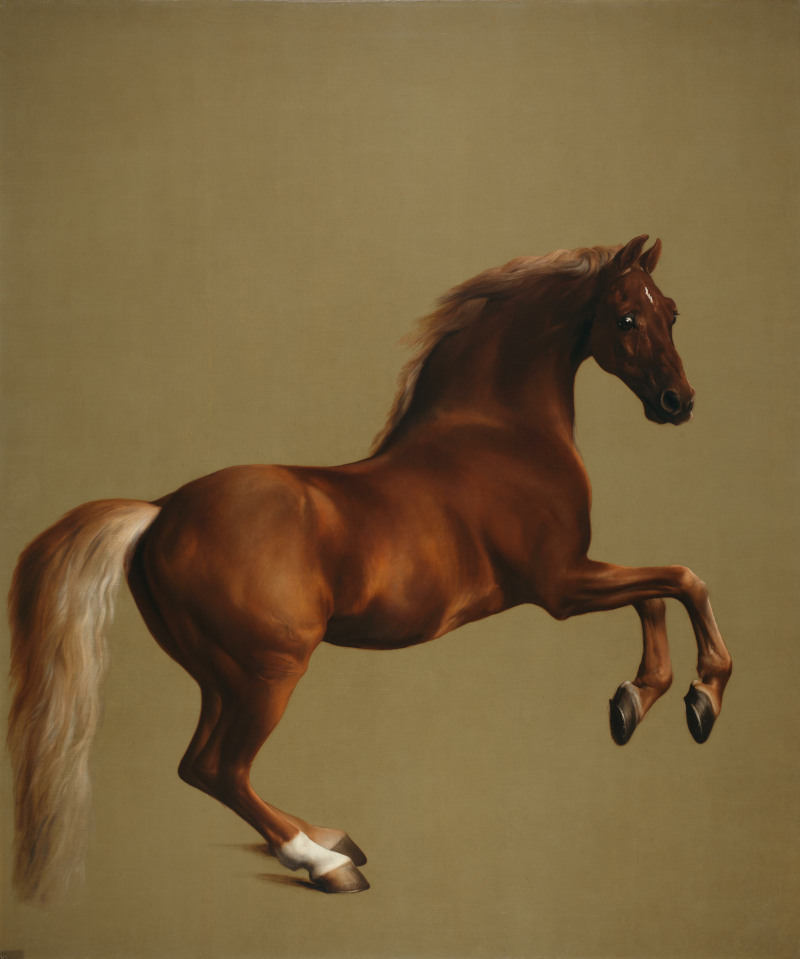 Whistlejacket by George Stubbs
Whistlejacket by George Stubbs
A Lion Attacking a Horse by George Stubbs
A Lion Attacking a Horse is amongst George Stubbs' finest works, and is also one of the more dramatic scenes featured in this list of famous horse paintings. Most of his other depictions of this animal were relatively surene, capturing horses whilst relaxing in the meadows and fields.
Within this interpretation he adds considerable emotion, arriving somewhere close to the Romanticism movement which was popular in the UK, and had begun in France. This painting shows the flexibility of the artist, able to capture the same horse in a variety of different guises, creating all manner of different moods within his paintings.
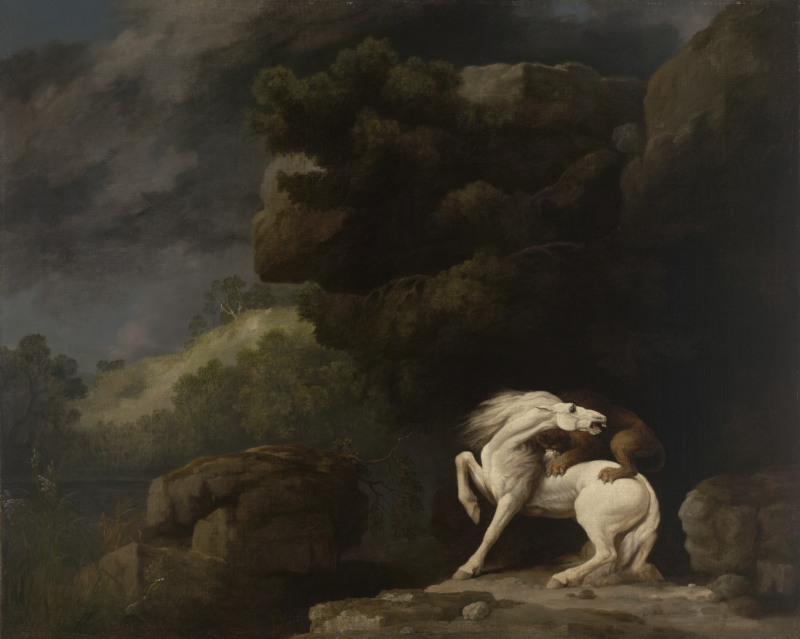 A Lion Attacking a Horse by George Stubbs
A Lion Attacking a Horse by George Stubbs
Napoleon Crossing the Alps by Jacques Louis David
Jacques Louis David's Napoleon Crossing the Alps combines great historical signifiance alongside impressive technical ability. This famous Frenchman was part of the Neoclassicism movement which re-invented old artistic styles for a new audience. David's connection to Napoleon, whom he painted several times, also ensured his legacy.
The composition features a strong, dominant leader pointing into the distance as he leads his soldiers onwards. The horse rises up, giving the impression of Napoleon's strength as he sits comfortably on the unsettled horse. Light is shone onto his facial features, as well as the muscles of the horses in a symbolic gesture.
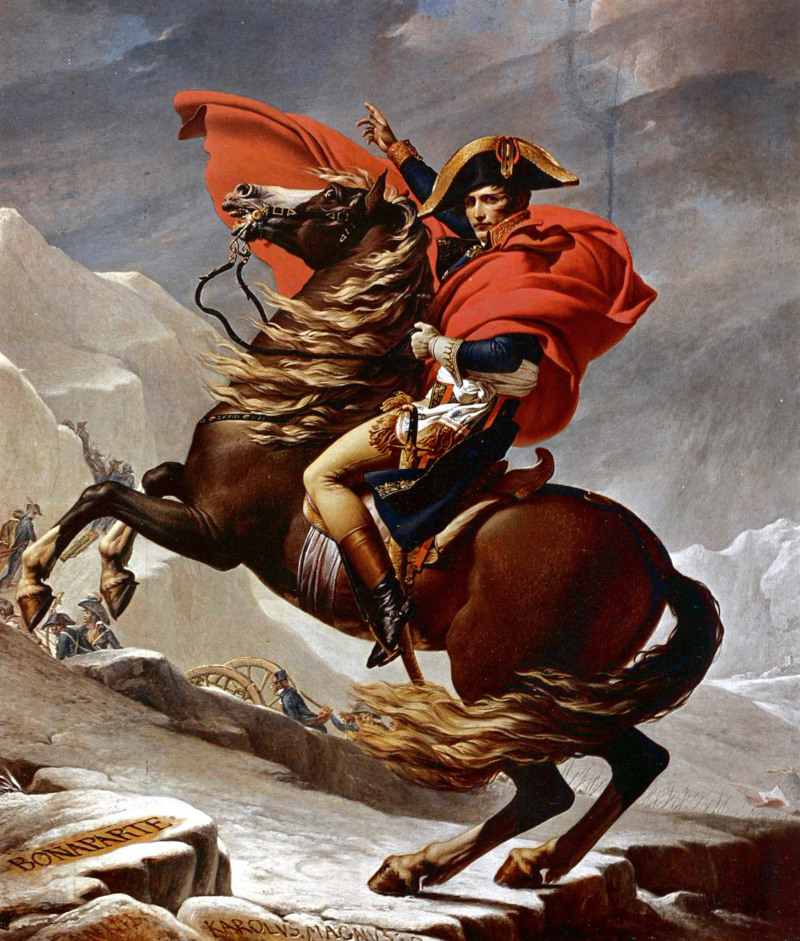 Napoleon Crossing the Alps by Jacques Louis David
Napoleon Crossing the Alps by Jacques Louis David
The Charging Chasseur by Theodore Gericault
The Charging Chasseur is a dramatic scene from the oeuvre of French Romanticism artist, Theodore Gericault. The horse is covered from behind, which is less flattering to the animal. We find the rider turned around, looking backwards towards potential danger. The horse looks to be concerned, rearing up with its front legs in the air.
Gericault was an important artist, coming early on in the rise of Romanticism. The likes of Delacroix, who himself produced large numbers of horse paintings, then followed his lead. Indeed, French artists have covered horses perhaps as much as any over the years, and are well represented in this list.
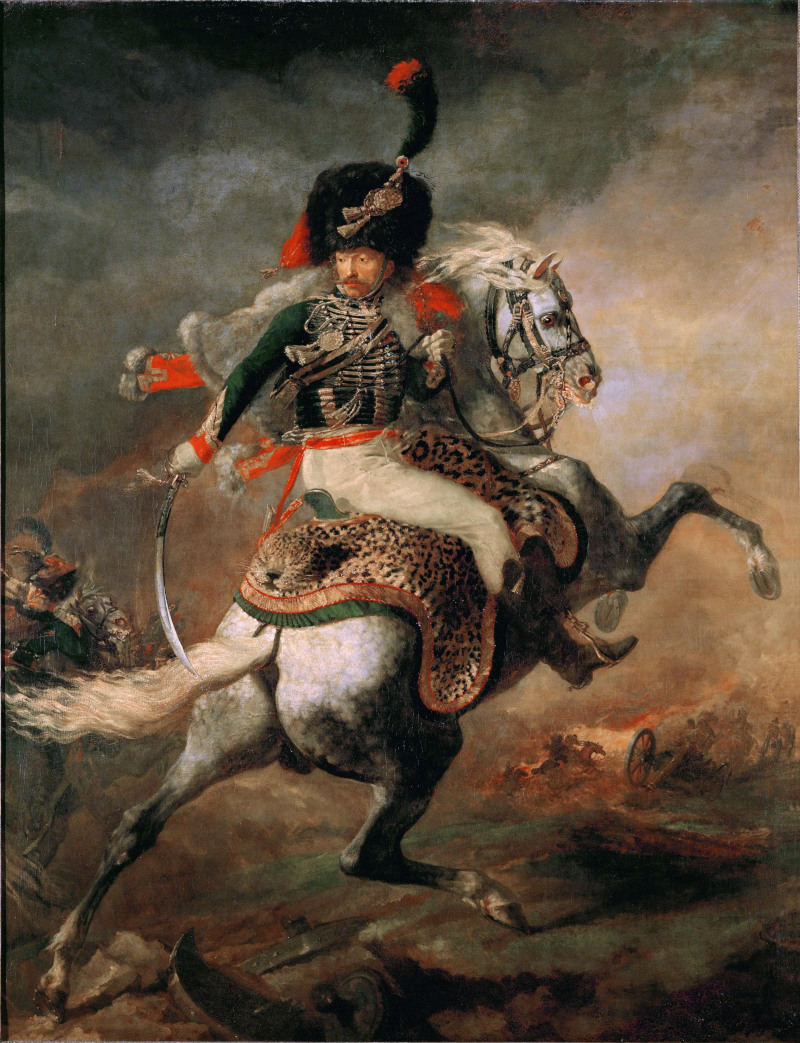 The Charging Chasseur by Theodore Gericault
The Charging Chasseur by Theodore Gericault
The Last of the Buffalo by Albert Bierstadt
The Last of the Buffalo is an important artwork which represents another community besides the normal European culture covered in most of this list. Bierstadt captured native America and combined it with the local landscape to produce beautiful paintings. Here we find man and animal fighting against the power of the buffalo.
Whilst the size of the horse is relatively small out of the overall composition, it is still important. Light captures the front of this creature, and it lifts its front legs up to avoid the charging buffalo. This painting also represents the different relationships that man can have with animals, both positive and negative.
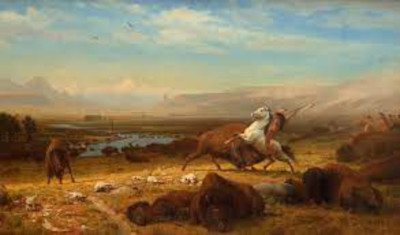 The Last of the Buffalo by Albert Bierstadt
The Last of the Buffalo by Albert Bierstadt
The Horse Fair by Rosa Bonheur
Rosa Bonheur produced a large number of horse paintings during her career. She studied the animal in great detail, and became confident in covering them from different angles and in all manner of environments. She would visit horse fairs in France, where she would study them in further detail and has a number of paintings with much the same title.
Lighting would be crucial, and she would saturate the backs of these strong but elegant creatures in order to lead the eye towards them. She tended to prefer white or light grey horses for this reason, and would darken the environment around them.
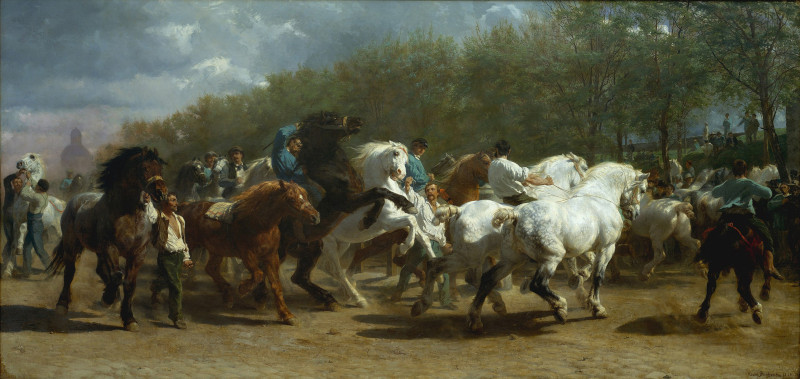 The Horse Fair by Rosa Bonheur
The Horse Fair by Rosa Bonheur
Lady Godiva by John Collier
Lady Godiva is a popular painting which captures beauty in a number of different aspects. Firstly, the slim female figure is stunning, as is the elaborate detail added to the clothing given to the horse. The animal looks strong and confident, with a proud posture as it looks off to the left hand side.
Behind them both we find a charming city scene, with medieval architecture perfectly setting the scene to fit the story of Lady Godiva. John Collier was a respected artist who lacked the fame of other British artists, but Lady Godiva has retained a great popularity despite that.
The Parade by Edgar Degas
Whilst most horse paintings featured in this article have only a single animal in each composition, Edgar Degas' The Parade features at least seven. The artist devoted a considerable amount of time to the French racehorse scene and regularly visited racecourses in order to capture scenes such as this.
Degas was interested in the activities of high society, but his focus on this theme also required him to accurately master the anatomy of the horse. His compositional method was unusual, with quirky angles which help us to feel like we are there ourselves, rather than viewing a perfectly composed artwork.
Blue Horse I by Franz Marc
Franz Marc was a gifted animal artist who worked in a bright, expressionist manner. This German painter covered horses several times, as well as pigs, tigers, foxes and more. He did now worry about accuracy or detail, but rather just captured the key elements of each animal within his consistent style that continues to remain popular today.
Within Blue Horse I we see a tall horse stretching to cover the entire vertical length of the painting. It leans its head to the side, and behind the horse we can see rolling hills in carefully selected colours which provide a warm mood.
Blue Horses by Franz Marc
Blue Horses features an unusual composition, in which the cropping is aggressive and modern. A group of horses in the foreground are closely packed together, seemingly comfortable in their own company. They lower their heads and the curves of these beautiful creatures create a rolling effect across the horizontal.
In order to allow them to stand out, the artist provides warm reds, oranges and yellows across the background. The palette is entirely unconnected to reality, helping to create a new world into which most of Franz Marc's paintings would fit. He remains amongst the most highly regarded German Expressionist artists.
The Blue Rider by Wassily Kandinsky
The Blue Rider is an example of Kandinsky's use of landscape art, within an expressive manner. These paintings arrived before his switch to heavily abstracted work, but are of equal merit within his overall career. The Blue Rider would become the name of a key movement too, giving this piece even more significance within his career.
The painting captures horse and rider on the right hand side of the composition, moving at speed across the artwork. A row of trees run across the top of the painting, with a blue sky showing through on the left hand side. The detail is relatively relaxed, with an expressive nature.
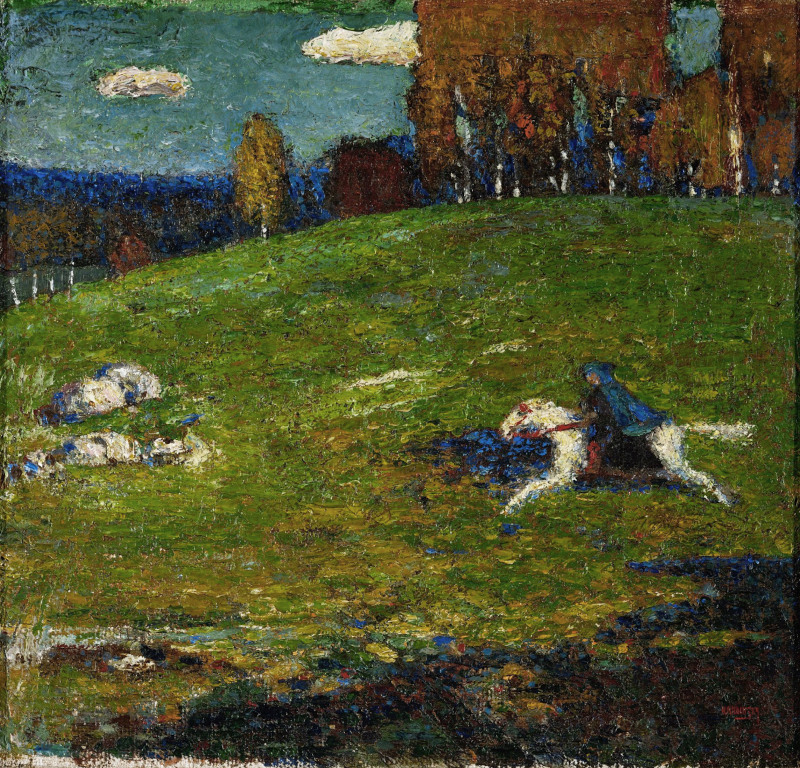 The Blue Rider by Wassily Kandinsky
The Blue Rider by Wassily Kandinsky
Boy Leading a Horse by Pablo Picasso
This delightful painting from 1906 is known as Boy Leading a Horse. Some consider it to have been a self portrait. The youngster confidently leads this tall, elegant horse towards the viewer. In the distance is a sandy, barren land which could be a region of Spain.
The two main figures are carefully crafted, with shadowing on the horse's front. It looks over towards the boy, suggesting a close bond and trusting relationship. Quite why the young man is undressed remains unclear.
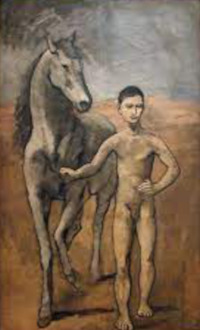 Boy Leading a Horse by Pablo Picasso
Boy Leading a Horse by Pablo Picasso
Horse (Drawing) by Pablo Picasso
Pablo Picasso was a master of drawing objects with just a single line. He remains amongst the most famous line artists in history, and this image represents a horse from side profile. He also captured other animals and birds, including a flamingo plus his own dog, Lump.
The artist regularly sketched in this manner, and enjoyed the creative challenge of representing an animal with just a single line, which had to be well planned and thought out in order to work effectively. Picasso returned to horses in a number of further drawings.
 by Pablo Picasso.jpg) Horse (Drawing) by Pablo Picasso
Horse (Drawing) by Pablo Picasso
The Role of Horses in History: Depictions in Artworks
The role of horses in art and history alike has changed considerably over the years. At times they have been used for their symbolic value, helping to raise the status of a rider. At other times artists have focused entirely on the animal itself, or groups of horses in a more natural setting.
In ancient times, such as in the Mesopotamia, Egypt, and Greece empires, we would find horses used to symbolise strength. They would also carry some mythological meanings in some cases, including a connection to various gods. By the middle ages in Europe, horses would represent noblemen and regal figures. They would be portrayed as strong and confident, riding their horse and physically being lifted above those around them.
Beyond that, some artists would then feature horses in more natural surroundings, simply celebrating the beauty of these creatures. This was combined with a rise in landscape painting, with the two often being featured together. The Romancism artists focused regularly on horses and attempted to feature their role in normal life, just as some Impressionists would also do.
As we went into more contemporary periods, greater expression would be used by the artist, and detail would start to be lost as forms of abstraction were also used. Most modern artists focus on the aesthetic qualities of the horse, with its curves, elegance and strong figure. The future is likely to bring further interpretations and it is hard to predict just where things will go next.
Equine Art in Contemporary Pop Culture: From Films to Fashion
Horses have played a major role in modern culture, going way beyond just the visual arts. Older films such as The Black Stallion, War Horse, and Seabiscuit sit alongside more modern adaptations such as Lords of the Rings and Game of Thrones have promoted the impact and role of horses within society.
Businesses today use horses within their branding, even their own logos, in order to leverage its symbolic qualities of grace and elegance. Others will incorporate the animal into its advertising, such as a number of UK banks. Other meaning it can bring includes speed, strength, and reliability.
The Equestrian Genre: Exploring the Relationship between Horse and Rider in Art
One of the reasons for capturing horse and rider is to be display a strong connection and relationship between man and animal. The human, typically, is putting their faith in the larger creature, and trusting them not to throw the rider off into the air. There have also been different activities covered, such as fighting together in war, or simply having a relaxed ride in the countryside.
In more recent times artists have attempted to capture the workings of the inner mind. Perhaps this can be achieved by focusing on non-verbal cues found in a friendship, which could be a light touch to the horses' head, or perhaps even feeding them.
The Poetry of Equine Movement: Dynamics and Gestures in Horse Art
Aspects of equine movement has fascinated artists and poets for centuries. The variety of movement from a canter, to full speed running has fascinated artists and led them to study this creature in great detail. Its use within sport has also brought these movements to the attention of the public, who see great variety in show jumping, horse racing, as well as more natural surroundings.
Likewise, poets have worked hard to depict and describe these different states in their literature, and often use them to set a particular mood. They might also focus on the relationships between horse and rider, and the psychology of those relationships. Even in just the small list of horse paintings found in this article, you will be able to examine the many different interpretations of the horse form within art over the past few centuries.
Horses in Mythology and Folklore: Legends and Symbols in Equine Paintings
Horses feature regularly within mythology, across a wide number of civilizations. Pegasus, the winged horse, is a great example from Greek mythology, and artists have covered this figure many times within art. Additionally, there is Sleipnir, the eight-legged horse ridden by the god Odin from Norse mythology, with horse and rider normally depicted together.
Horses are considered one of just a few sacred animals within China, and have understandably therefore been included in Chinese art fairly regularly. Their inclusion tends to bringing an atmosphere of good fortune and harmony within this ancient and rich culture. There is also Celtic goddess Epona who normally is depicted on horseback, plus countless other examples from more recent times.
The Influence of Equestrian Sports: Representations in Horse Paintings
Equestrian sport art is a popular pursuit for amateur, and less known professional artists, with their work often sold in appropriate locations where the subject is perhaps more important than the quality of the artwork. There have been only a few famous artists who have tackled equestrian sports within their oeuvre, with Edgar Degas probably being the most famous of those.
The Frenchman regularly visited race meetups early in his career and captured the exciting lifestyle enjoyed by visitors to these prestigious occasions. He held a strong interest in figurative art and would stretch that across to animals after becoming interested in these beautiful creatures.
Beyond the Canvas: Exploring Horse Sculptures and Installations
Horse sculptures have followed in the style of paintings and drawings, but have had the added benefit of bringing in the third dimension. Small horse sculptures can be given as prizes, perhaps for winners in equestrian sports. Larger sculptures reflect the strength, size and beauty of this animal, and sometimes will include riders on top, perhaps to represent a famous figure from the past.
Horse Racing in Art: Capturing the Thrill and Energy on Canvas
Speed and movement has attracted artists for many years, and there is litle more thrilling than the sight of a horse and rider making their way across a horse race. With the added contrast of an excited crowd watching on, as well as the significant cultural aspect of sport more generally, there is much to attract an artist in this theme.
Some artists will blur the lines of the horse in order to accentuate the feeling of movement, and this was a technique used by the Impressionists on other topics. It represents what we see with our eyes, or even in a photograph, when things move at pace.
Unleashing Creativity: Modern Approaches to Horse Paintings
Modern art allows a full flexibility, where artists are encouraged to pick their own approach and innovate as much as possible. The standard artworks of the past, with traditional depictions of horses, are therefore out of fashion, and more abstract, brighter scenes are now more commonplace.
The Power of Color: Expressing Emotions Through Equine Art
Horses can in a variety of colors, and artists would often pick the right horse for their painting. Its build would be significant, as well as its tone. Typically, artists like lighter tones which better reflect light from above, but in other cases a darker toned horse might suit instead. It may also depend on what happens to be available in the region the artist lives, and some may not have easy access to many animals.
Modern art would move away from accuracy, and artists would regularly choose their own colors with which to depict a horse. It may not matter to them as to its real color and they would choose something that would better suit the painting overall.
From Racehorses to Wild Stallions: Exploring Different Subjects in Horse Paintings
Horses bring a great variety, in terms of size, color, build, breed and more. Wild stallions provide an exciting, unpredictable nature to a painting, where as highly trained horses give a completely different atmosphere, boasting control and discipline.
The choice will also impact the rest of the composition, be it on a race course or out in the countryside. You might even find horses in a truly wild environment, allowing us to understand the raw nature of the animal much better.



